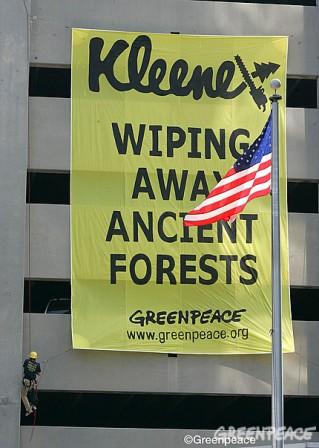Paper appears to be high on the agenda of a number of organizations this week. It’s necessary. Paper is so ubiquitous – from tissues to toilet paper to memo pads to catalogs to the mess on your desk – that it is easy to forget, or perhaps more convenient to ignore, that paper manufacturing has significant environmental repercussions.
Paper production is the third largest contributor to climate change, the biggest source of deforestation and has a significant impact on water issues. It’s a dirty business, from the use of toxic chemicals and chlorine bleaches to clear-cutting of forests like this one on the North Carolina Coast:
The Environmental Paper Network (EPN), a coalition of environmental organizations including As You Sow, Conservatree, Green America, Dogwood Alliance, ForestEthics, Green Press Initiative, Markets Initiative, National Resource Council of Maine, National Wildlife Federation, and Rainforest Action Network, launched a new website, WhatsInYourPaper.com. The site is designed to help consumers and corporations buy paper that is more environmentally friendly. The purchaser’s tool kit includes a sample supplier letter, a guide to saving paper and a guide to environmentally preferable purchasing. Some of the suggestions are simple and can apply to individuals as well as corporations, like using electronic communications, reducing the default margins in MS Word and double sided printing.
These strategies may seem obvious, but I assure you that for many, they aren’t. In fact, in my first job out of college, I was a glorified assistant and my boss used to type on a piece of paper “please type the following onto an envelope” with a name and address. At the time, I thought he was just condescending; now I know that he was incredibly wasteful, too.
Companies and their purchasing agents sometimes don’t have a clue. Take for example, the ForestEthics campaign against Victoria’s Secret use of paper from clear cutting of Canada’s ancient Boreal forest for their famous catalogue, and their ultimate collaboration once they had been helped to see the light:
Kudos to Tom Katzenmeyer, Sr. Vice President at Limited Brands, for encouraging other corporations to partner with NGOs and becoming advocates for better paper choices.
According to EPN, the most environmentally friendly papers contain at least 50% post-consumer recycled materials, is processed chlorine free and any virgin fiber comes from Forest Stewardship Council (FSC) certified sources. 50% post-consumer recycled paper emits 19% – 25% less greenhouse gases and 100% post-consumer recycled paper emits 25% – 50% fewer greenhouse gases.
Related Post: 20 Smart Uses For Shredded Paper Around The Home
For those companies that need to know how to replace their current paper with environmentally friendly alternatives, Environmental Defense Fund (EDF) has a Paper Calculator that allows users to compare individual paper types and groups to find the best choice of a replacement without too much compromise on weight, texture or brightness. Paper manufacturers like Mohawk and New Leaf are real leaders from the supplier side and offer many choices.
Greenpeace has just put out a Recycled Tissue and Toilet Paper Guide that addresses papers of a different sort.; the kind we use in our bathrooms and kitchens. They suggest using cloth whenever possible. Remember your Dad’s hanky? It might be time to bring that back. Ditto the cloth napkin. And don’t forget the very retro dish towels and cloth rags. It’s a good rule of thumb that the non-disposable option is generally the better one.

For those paper products you do buy, there are three criteria Greenpeace suggests: 100% recycled content, at least 50% post consumer recycled content and no chlorine bleach. Their pocket guide puts Green Forest products at the top for facial tissues, toilet paper and paper towels and as a recommended brand for paper napkins. Seventh Generation and the Whole Foods 365 brand both ranked well in all 4 categories, as well.
At the bottom of the paper pile? Kleenex, Puffs, Scott, Brawny, Bounty, Viva, Charmin, Wal-Mart brands and a host of other highly recognizable brand names. Greenpeace has had a long standing campaign, Kleenex=Kleercut, to pressure Kimberly-Clark to stop cutting down ancient forests and use recycled materials.
There is simply no reason that it should take 90 years to grow a box of facial tissues or that we should be flushing ancient trees down the toilet or using them for memos that end up in the circular file. As Dr. Allen Hershkowitz of the Natural Resources Defense Council (NRDC) pointed out to a group of Hollywood moguls at a conference last year, if you are going to do just one thing for the environment, buy toilet paper made from recycled materials. I recommend the Seventh Generation 2-ply toilet paper, it’s as soft as Charmin. For facial tissues, I’m partial to Green Forest. Get paper smart, or better yet, become a recycled paper evangelist.
Image Credit: Greenpeace










































Unfortunately recycled content bathroom tissue contains BPAs. Why? Because when paper is recycled, thermal paper is also thrown in. Thermal paper is paper coated with plastic, as in credit card receipts.
This is only a problem when you consider recycled content bathroom tissue is being flushed down the toilet, eventually contaminating ground water with build up of small amounts of plastic.
I have one possible solution. I developed a new bathroom tisse made from (renewable and sustainable )bamboo non woven fibers. Please check it out. It is soft, smooth, breaks down quickly, bpa free, elemental chlorine free, and is packaged in a 100% recycled cardboard box. http://www.bumboosa.com We also plant a tree for every product sold and we are committed to alleviating the burden on trees, whether those trees are from ancient forests or managed tree farms.